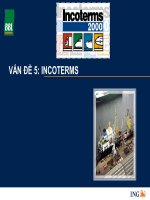BÀI GIẢNG kế TOÁN QUỐC tế chapter 3 accounting conventions
Bạn đang xem bản rút gọn của tài liệu. Xem và tải ngay bản đầy đủ của tài liệu tại đây (185.78 KB, 18 trang )
Part B
THE QUALITATIVE
CHARACTERISTICS OF
FINANCIAL INFORMATION AND
THE FUNDAMENTAL BASES OF
ACCOUNTING
1
Part B
Chapter 3: Accounting conventions
2
Chapter 3
ACCOUNTING CONVENTIONS
Learning Objectives
1.
2.
3.
4.
5.
6.
Background
IAS 1
The IASB’s Framework
Criticisms
Bases of valuation
IAS 8
4
Background
• Accounting policies have developed over
the centuries. They are based on
generally accepted concepts.
•Fair presentation
•Going concern
•Accruals or matching
•Consistency
•Prudence
•Materiality
•Substance over form
•Relevance
•Reliability
•Faithful representation
•Neutrality
•Completeness
•Comparability
•Understandability
5
IAS 1
• IAS 1 Presentation of financial statements considers
accounting policies, fundamental assumptions and
the format and content of financial statements.
Accounting
policies and
explanatory
notes
Statement of
financial position
Financial
Financial statements
statements
Statement of
cash flows
Income statement
Statement of
changes in
equity
6
IAS 1
• Directors are also encouraged to prepare a
financial review and any other reports or
statements which may aid users.
• Objective: To prescribe the basis for
presentation of general purpose financial
statements, in order to ensure comparability
both with the entity’s own financial
statements of previous periods and with the
financial statements of other entities.
7
IAS 1
• Financial statements should present fairly
financial performance, financial position
and cash flows. Compliance with IFRSs
will help to ensure this.
8
IAS 1
• Going concern: The entity will continue in
operation for the foreseeable future. There is no
intention to put the entity into liquidation or to
make drastic cutbacks to the scale of the
operations.
• Accruals: Revenue and costs must be recognised
as they are earned or incurred, not as money is
received or paid. They must be matched with one
another so far as the relationship can be
established or justifiably assumed and dealt with
in the I/Sin which they were incurred.
9
IAS 1
• Prudence: The inclusion of a degree of
caution in the exercise of judgement, such
that assets or income are not overstated
and liabilities or expenses are not
understated
• Consistency: The presentation and
classification of items should stay the
same from one period to the next.
10
IAS 1
• Materiality: Information is material if its
omission or misstatement could influence
the economic decisions of users.
• Substance over form: Transactions and
other events are accounted for and
presented according to their substance
and not just their legal form.
11
The IASB’s Framework
• Fair presentation: compliance with IFRSs should be
disclosed.
• Relevance: information provided satisfies needs of users.
• Reliability: information is free from material error or bias.
• Faithful representation: only recognised if financial effects
are certain.
• Neutrality: information must be free from bias.
• Completeness: information gives rounded picture.
• Comparability: consistent basis used so valid comparison
can be made with other periods.
• Understandability: information may be difficult to understand
if it is incomplete, but too much detail can confuse.
12
The IASB’s Framework
Good accounting information has the following
qualities:
•Relevance
•Understandability
•Reliability
•Comparability
•Objectivity
•Timeliness
•Completeness
13
The IASB’s Framework
The four principal qualitative characteristics
defined by the IASB Framework are:
•Relevance
•Reliability
•Understandability
•Comparability
14
Criticisms
Some criticisms have been made of financial accounts. They include
the following.
•Accounts are becoming more complex, containing material which is:
–Not applicable to small companies
–Incomprehensible to the layman
•Information prepared for external reporting purposes is not generally
useful for internal decision making purposes.
•Financial statements do not necessarily give a good indication of the
suitability of the company for investment and the likelihood of its future
success.
•Conventional financial statements do not always provide users with
the kind of information they want.
•The historical cost convention, under which financial statements are
still prepared, may be misleading.
15
Bases of valuation
• Historical cost: means that transactions are
recorded at the cost when they occurred
• Net realisable value: means the estimated selling
price less the estimated costs of completion and the
estimated costs to make the sale.
• Replacement cost: means the amount needed to
replace the asset with an identical asset.
• Economic value: means the amount of the profits
an asset is expected to generate during its
remaining life.
16
Bases of valuation
Criticisms of historical cost accounting:
Historical cost accounting can be misleading for the following
reasons.
•Non-current asset values are unrealistic
•Depreciation is inadequate to finance purchase of new
assets
•Holding gains on inventories are included in profit
•Profits (or losses) on holdings of net monetary items are not
shown
•The true effect of inflation on capital maintenance is not
shown
•Comparisons over time are unrealistic
17
IAS 8
IAS 8 Accounting policies, changes in
accounting estimates and errors
You should know the definitions of the following:
•Prospective application
•Retrospective application
•Prior period errors
•Accounting policies
Correction of prior period errors and changes of
accountancy policy require retrospective application.
18









